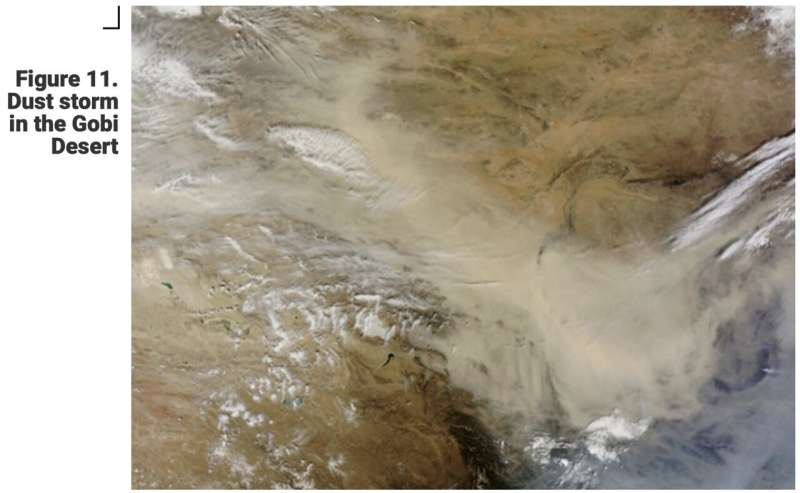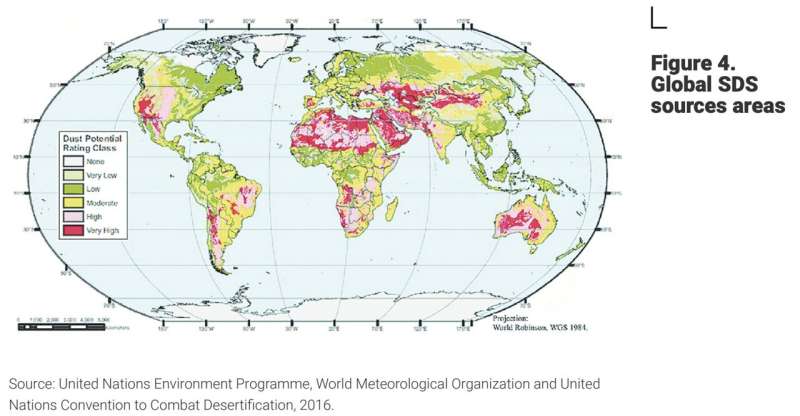This article has been reviewed according to Science X's editorial process and policies. Editors have highlighted the following attributes while ensuring the content's credibility:
fact-checked
proofread
Sand and dust storm frequency increasing in many world regions, UN warns

Sand and dust storms are an under-appreciated problem now "dramatically" more frequent in some places worldwide, with at least 25% of the phenomenon attributed to human activities, according to the UN Convention to Combat Desertification (UNCCD).
Accompanied by policy recommendations, the warning comes as a five-day meeting takes place in Samarkand, Uzbekistan to take stock of global progress in the Convention's implementation. The UNCCD is one of three Conventions originated at the 1992 Earth Summit in Rio de Janeiro. The other two address climate change (UNFCCC) and biodiversity (UN CBD).
The meeting, held from 13–17 November, includes a high-level session on 15 November hosted by the Government of Uzbekistan on ways to address the impacts of sand and dust storms on global agriculture, industry, transportation , water and air quality, and human health.
UNCCD's Executive Secretary, Ibrahim Thiaw says, "The sight of rolling dark clouds of sand and dust engulfing everything in their path and turning day into night is one of nature's most intimidating spectacles. It is a costly phenomenon that wreaks havoc everywhere from Northern and Central Asia to sub-Saharan Africa."
"Sand and dust storms present a formidable challenge to achieving sustainable development. However, just as sand and dust storms are exacerbated by human activities, they can also be reduced through human actions," adds Thiaw.
While sand and dust storms (SDS) are a regionally common and seasonal natural phenomenon, the problem is exacerbated by poor land and water management, droughts, and climate change, according to UNCCD experts.
And fluctuations in their intensity, magnitude, or duration "can make SDS unpredictable and dangerous."
With impacts far beyond the source regions, an estimated 2 billion tons of sand and dust now enters the atmosphere every year, an amount equal in weight to 350 Great Pyramids of Giza.
In some areas, desert dust doubled in the last century.
"Sand and dust storms (SDS) have become increasingly frequent and severe having substantial transboundary impacts, affecting various aspects of the environment, climate, health, agriculture, livelihoods and the socioeconomic well-being of individuals. The accumulation of impacts from sand and dust storms can be significant," says Feras Ziadat, Technical Officer at the Food and Agriculture Organization of the UN (FAO), Chair of the UN Coalition on Combating Sand and Dust Storms.
"In source areas, they damage crops, affect livestock, and strip topsoil. In depositional areas atmospheric dust, especially in combination with local industrial pollution, can cause or worsen human health problems such as respiratory diseases. Communications, power generation, transportation, and supply chains can also be disrupted by low visibility and dust-induced mechanical failures. The United Nations Coalition on Combating Sand and Dust Storms, chaired by FAO, was created in 2019 to lead global efforts to address SDS."
In their Sand and Dust Storms Compendium and accompanying SDS Toolbox, the UNCCD, FAO and partners offer guidance on approaches and methodologies for collecting and assessing SDS data, monitoring and early warning, impact mitigation and preparedness, and source mapping and anthropogenic source mitigation at sub-national, national, regional and global levels.
The SDS discussion forms part of the agenda of this year's meeting in Uzbekistan of the UNCCD's Committee for the Review of the Implementation of the Convention (CRIC 21) and global progress in delivering the Convention's strategic objectives. It marks the first time since its establishment that UNCCD has agreed to one of its most significant meetings in Central Asia.

The meeting comes at a critical juncture, as recent statistics published via UNCCD's new data dashboard shows the world now losing nearly 1 million square kilometers of healthy and productive land every year—some 4.2 million square kilometers between 2015–2019, or roughly the combined area of five Central Asian nations: Kazakhstan, Kyrgyzstan, Tajikistan, Turkmenistan and Uzbekistan.
Background: Sand and dust storms
Sand and dust storms (SDS) are known by many local names: the sirocco, haboob, yellow dust, white storms, or the harmattan.
While SDS can fertilize both land and marine ecosystems, they also present a range of hazards to human health, livelihoods and the environment.
SDS events typically originate in low-latitude drylands and sub-humid areas where vegetation cover is sparse or absent.
They can also occur in other environments, including agricultural and high-latitude areas in humid regions, when specific wind and atmospheric conditions coincide. SDS events can have substantial transboundary impacts, over thousands of kilometers. Unified and coherent global and regional policy responses are needed, especially to address source mitigation, early warning systems, and monitoring.
SDS often have significant economic impacts: for example, they cost the oil sector in Kuwait an estimated US$ 190 million annually, while a single SDS event in 2009 resulted in damage estimated at US$ 229–243 million in Australia.
The major global sources of mineral dust are in the northern hemisphere across North Africa, the Middle East and East Asia. In the southern hemisphere, Australia, South America and Southern Africa are the main dust sources.
More than 80% of Central Asia is covered by deserts and steppes which, coupled with climate change and lasting droughts, represent a major natural source of sand and dust storms.
The dried-up Aral Sea is a major source of SDS, emitting more than 100 million tons of dust and poisonous salts every year, impacting the health not just of the people living in the vicinity, but far beyond and generating annual losses of US$ 44 million.
Recognition of SDS as a disaster risk appears to be high in North-East Asia, parts of West Asia and North America but less prominent elsewhere.
Low recognition of SDS as a disaster risk is likely due to the lack (in many cases) of significant immediate direct human fatalities or injuries from individual SDS events, and limited consolidated documentation on their long-term health, economic or other impacts.

SDS and health
SDS can be life-threatening for individuals with adverse health conditions.
Fine dust particles are carried to high tropospheric levels (up to a few kilometers high) where winds can transport them over long distances.
The health implications of SDS have been under increased research for decades, with most studies conducted in East Asia, Europe and the Middle East. There has been a lack of studies in West Africa.
A particular focus of this research has been SDS modification of air pollution.
The cause-and-effect between sand and dust in the atmosphere and health outcomes remains unclear and requires more extensive study. What can be said is that at-risk members of a population, especially those with pre-existing cardiopulmonary issues, including childhood asthma, may have a higher mortality or morbidity rate during a dust storm.
SDS can also impose major costs on the agricultural sector through crop destruction or reduced yield, animal death or lower yields of milk or meat, and damage to infrastructure.
For annual crops, losses are due to burial of seedlings or crops under sand deposits, loss of plant tissue and reduced photosynthetic activity as a result of sandblasting. This can lead to complete crop loss in a region or reduced yield.
There may also be a longer-term effect on some perennial crops due to tree or crop damage (such as lucerne/alfalfa crowns being damaged).
On a positive note, SDS dust can contain soil nutrients such as nitrogen, phosphorus and potassium, as well as organic carbon. Some places benefit from this nutrient deposition on land, and mineral and nutrient deposition on water, particularly ocean bodies. When deposited, these can provide nutrients to downwind crop or pasture areas. These limited benefits, however, are far outweighed by the harms done.
Globally, the main large dust sources are dried lakes; Local sources include glacial outwash plains, volcanic ash zones and recently plowed fields.
The multi-faceted, cross-sectoral and transnational impacts of SDS directly affect 11 of the 17 Sustainable Development Goals yet global recognition of SDS as a hazard is generally low due in part to the complexity and seasonally cumulative impact of SDS, coupled with limited data .
Insufficient information and impact assessments hinder effective decision-making and planning to effectively address SDS sources and impacts.
UNCCD helps governments create policies to promote the scaling-up of sustainable land management practices and to find and use the latest science to develop and implement effective mitigation policies.
Working with The Regional Environmental Center for Central Asia, UNCCD assists countries vulnerable to drought and sand and dust storms in Central Asia to develop and implement risk reduction strategies at national and regional level. UNCCD encourages countries to adopt a comprehensive risk reduction strategy with monitoring and early warning systems to improve preparedness and resilience to these environmental disasters.
Among the measures most needed are
- A multi-sector approach bolstered by information-sharing, short- and long-term interventions, engaging multiple stakeholders, and raising awareness of SDS.
- Land restoration, using soil and water management practices to protect soils and increase vegetative cover, which have been shown to significantly reduce the extent and vulnerability of source areas, and reduce the intensity of typical SDS events.
- Early warning and monitoring, building on up-to-date risk knowledge, and forecasting, with all stakeholders (including at-risk populations) participating to ensure that warnings are provided in a timely and targeted manner
- Impact mitigation, through preparedness to reduce vulnerability, increase resilience, and enables a timely, effective response to SDS events
Provided by United Nations Convention to Combat Desertification




















